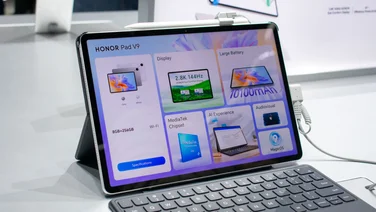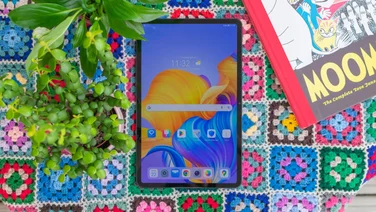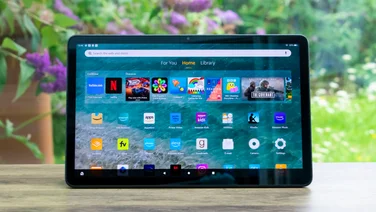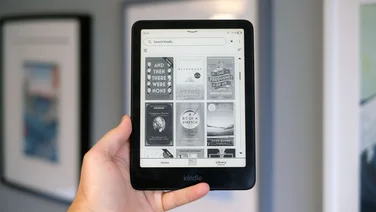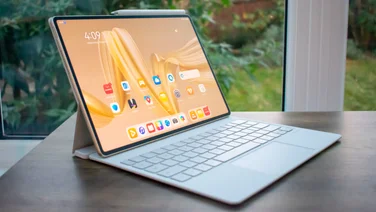To help us provide you with free impartial advice, we may earn a commission if you buy through links on our site. Learn more
- Apple iPad Air 4 (2020) review: What you need to know
- Apple iPad Air 4 (2020) review: Price and competition
- Apple iPad Air 4 (2020) review: Design and keyboard
- Apple iPad Air 4 (2020) review: Display
- Apple iPad Air 4 (2020) review: Performance
- Apple iPad Air 4 (2020) review: Camera
- Apple iPad Air 4 (2020) review: Verdict











- Nearly as fast as the iPad Pro
- Thin and light
- Decent camera
- Accessories are expensive
The 2020 iPad Air is, like most of Apple’s tablets, very firmly a productivity tool. When coupled with a keyboard, it’s a 2-in-1 laptop by another name, a machine you can do all your work on and more. And, despite lacking the “Pro” moniker it’s every bit the professional-level tablet its stablemates are.
There are differentiating factors, of course; Apple is always careful to ensure that. And there are tangible reasons why you might choose the more expensive iPad Pro over this, the fourth-generation iPad Air.
Apple iPad Air 4 (2020) review: What you need to know
Those reasons are principally camera related. The iPad Pro, for instance, has a LiDAR sensor where the iPad Air does not. This is intended to enhance the tablet’s depth-sensing capabilities, improving camera autofocus and enhancing AR (augmented reality) functionality. The iPad Air also lacks the Pro’s secondary ultrawide camera and isn’t quite as powerful.
Not that the iPad Air’s processor is sluggish. It uses the same processor that powers the latest generation of iPhones, the groundbreaking 5nm A14 Bionic. And, although it isn’t quite a match for the A12Z, which has eight CPU and GPU cores, it is quicker than the previous generation iPad Pro (2018) by quite a margin.











The only other significant differences between the Air and the Pro are that the Air uses Apple’s new TouchID fingerprint reader, built into the power button on the tablet’s edge, instead of FaceID, and that it has a bog-standard 60Hz display where the Pro’s goes up to 120Hz.
Otherwise, the iPad Air looks uncannily like a cutback iPad Pro 11in. Its 10.9in display is a tiny bit smaller but not to the extent that you’d notice. It’s manufactured in the same style, with flat sides and rear and rounded corners, and it’s compatible with the same accessories too: the Apple Pencil 2 and new style Magic Keyboard.
READ NEXT: Our guide to the best tablets money can buy
Apple iPad Air 4 (2020) review: Price and competition
The principal attraction of the iPad Air is that, despite the similarities, it’s very much cheaper than the iPad Pro. At £579 (for the 64GB Wi-Fi only model), it is £190 less expensive than the 11-inch iPad Pro, though the latter does have twice as much storage at this price.
Alas, the accessories aren’t any cheaper. The tablet on its own might look reasonable but add the Magic Keyboard (£299) and Apple Pencil 2 (£119) and that price nearly doubles to £997. You can equip your Air with the cheaper Smart Keyboard Folio, cutting £120 off the total price, but that’s still too much to spend on a keyboard cover in my view.
You can opt for more storage if you want, up to 256GB, and add 4G connectivity too, but this raises the price significantly. The most expensive iPad Air with both upgrades costs £859.
The only serious opposition in the Android camp comes from the 11in Samsung Galaxy Tab S7, which costs £619 for the cheapest Wi-Fi only model. For that price, it has double the storage of the base iPad Air and comes bundled with an S Pen stylus. Its official keyboard case is £189, bringing it in at £708 for the tablet, stylus and keyboard package.
Apple iPad Air 4 (2020) review: Design and keyboard
Apple by now has mastered the art of designing attractive, well-made pieces of computing hardware and the iPad Air 4th generation doesn’t stray from that path. It’s a solid-feeling slab of aluminium and glass, and comes in five different colours: the familiar dark grey, silver and rose gold, plus two new and rather lovely shades of pastel blue and green.
Dimensions and weight are barely different from the iPad Pro 11-inch. The Air measures 179 x 6.1 x 248mm (W x D x H) and weighs 458g (460g for the cellular model) and its other physical characteristics are familiar as well. With the tablet mounted in the Magic Keyboard (landscape), the volume buttons and power button/fingerprint reader are located on the top left corner, the magnetic charging strip for the Apple Pencil 2 is on the top edge, the USB-C port is on the right edge and there are four speaker grilles on both the left and right edges. These output surprisingly full-bodied stereo audio, whether you keep the tablet in landscape or spin it around and hold it in portrait mode.











And, just as with the iPad Pro, there are three small contacts on the right side of the rear (again when viewed in landscape from the front) that provide the power and data connection for the Magic Keyboard and Smart Keyboard Folio cases.
It’s a fantastic design and, when paired with that new Magic Keyboard it feels almost as comfortable to use as the larger 12.9in iPad Pro. The backlit keys have a decent amount of travel to them and a nice soft feel, and the layout feels a lot more spacious than you’d expect it to.
Yes, some keys are reduced in width – the semicolon, apostrophe and backslash keys in particular – but the letter keys are all large enough to stave off typos when touch typing and I found it very easy to get up to speed on it.











The touchpad works just as nicely as it does on the iPad Pro tablets, with iOS 14’s two- and three-fingered multitouch gestures simple to carry out, and the iPad Air also benefits from iOS 14’s new Scribble feature. For owners of an Apple Pencil, this converts handwritten notes to text in a variety of situations across iOS, and in the iOS Notes app turns your wobbly hand-drawn shapes into crisp, geometric masterpieces. Alas the feature isn’t supported across all apps yet – it doesn’t, for example, currently let you handwrite text directly into Google Docs.











The one slightly awkward dent in the iPad Air’s appeal is, surprisingly, the new TouchID power button. This works absolutely fine and I’ve had no recognition failures with it yet. However, it’s not always as easy to find as you might think. Depending on how you pick up the tablet, the reader might be in the top-left, top-right, bottom-left or bottom-right corner and that means you have to think about where to place your finger. FaceID on the iPad Pro, on the other hand, works instantly, whichever way around you hold the tablet.
READ NEXT: Our guide to the best tablet money can buy
Apple iPad Air 4 (2020) review: Display
Dig beneath the surface of the iPad Air’s specifications and differences between it and the pricier Pro family of tablets starts to become more apparent. The display, for instance, is a similar size, resolution and pixel density (264ppi) to the 11in iPad Pro, but doesn’t have the slick ProMotion refresh rate technology, which can run at up to 120Hz.
Instead, the iPad Air’s screen is limited to 60Hz and, as a result, it doesn’t quite feel as fluid under the finger and to the eye as the iPad Pro. Otherwise, there’s nothing major amiss here. For your money, you’re getting a wide-gamut display capable of reproducing the P3 colour space and one that supports both HDR10 and Dolby Vision content.











In testing, it impressed us with its sRGB coverage and accuracy as well, reaching a peak brightness of 420cd/m² and a contrast ratio of 1,355:1, while colour accuracy within sRGB was excellent with a measured average Delta E of 1.16 and sRGB coverage of 95.1%.
In all, it’s an excellent screen, which is what we’ve come to expect from Apple over the years. It lacks the inky black and perfect contrast of the Samsung Galaxy Tab S7 and S7 Plus because it’s using IPS LCD technology instead of AMOLED but it’s still very, very good.
Apple iPad Air 4 (2020) review: Performance
The six-core 5nm Apple A14 Bionic chip running affairs inside the iPad Air’s chassis is the same as used inside the latest generation of iPhones. It’s two CPU cores short of the iPad Pro (2020)’s eight-core A12Z and it’s also short on GPU core-count with only four compared to the more expensive tablet’s eight.
That doesn’t mean the iPad Air lacks speed or potency, however – far from it. The new iPhones are the fastest on the planet and, since they’re effectively miniaturised computers, there’s no reason the same silicon can’t also perform well in a laptop or tablet like the iPad Air.
If you don’t believe me, take a look at the graphs below, where I’ve compared the iPad Air directly with not only the iPad Pro (2020) and Samsung’s most recent Android tablets but also a selection of lightweight Windows 10 and MacOS laptops:


You’ll see that the iPad Air 2020 only lags noticeably behind the iPad Pro: its single-core CPU performance is superior but multi-core and graphics performance are both slower. Otherwise, it is quicker than everything else on these graphs, including the cheapest Core i3 MacBook Air (2020), the Core i5 Samsung Galaxy Book Ion and the Core i7 Microsoft Surface Pro 7.
With raw performance this strong, no wonder Apple is planning to move its MacBooks to its own silicon over the next couple of years. It’s just a shame that there still remain some fundamental roadblocks to using an iPad as a full-blown laptop replacement, not least the iPad’s restrictive external monitor support.
Battery life, meanwhile, is strong but nothing out of the ordinary. In our video rundown test, where we set the display to a brightness of 170cd/m2, disable auto-brightness and True Tone, and engage flight mode, the iPad Air lasted 9hrs 26mins, which is around the same as the iPad Pro 12.9in (2020) and an hour and a half short of the Samsung Galaxy Tab S7 Plus.

Apple iPad Air 4 (2020) review: Camera


The camera is pretty good, too, and if you ever find yourself with your iPad in hand instead of your smartphone, you’ll find it a competent companion. There’s no flash or secondary ultrawide camera as you get on the iPad Pro, and the results look a little less contrasty and softer in some circumstances. By and large, though, photographs captured with the 12MP f/1.8 camera look great:
Apple iPad Air 4 (2020) review: Verdict
Apple might not call this tablet an iPad Pro but the 4th-generation iPad Air is very much a tablet that deserves to be viewed in the same light, and mentioned in the same breath. It’s a brilliantly usable productivity tablet and a highly capable laptop replacement, wrapped up in a slim, lightweight, attractive package.
Its performance is as good as, if not better, than some rival ‘proper’ laptops and, critically, it’s very competitive on price.
In short, if you can live with the limitations of iPadOS over Windows 10 or MacOS, the iPad Air makes a brilliant laptop replacement and is certainly better value than the 11-inch iPad Pro.




